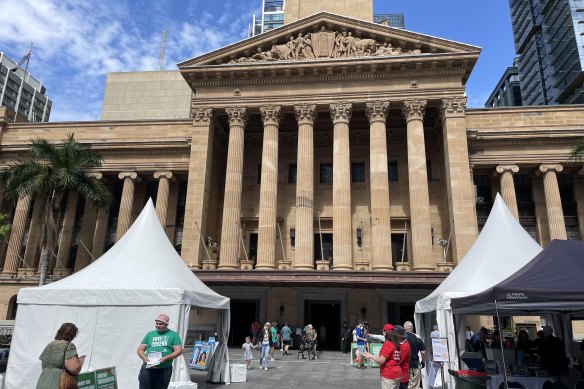This was published 7 months ago
How the dust has settled on Queensland's council elections
By Matt Dennien
It’s been three weeks since Queenslanders finished casting votes for their next batch of mayors and councillors.
But while the results were closely and publicly monitored in Brisbane – the country’s biggest council – on the night, the official count there took a little more time.

Polls closed at Brisbane City Hall, and across the rest of the state, at 6pm on Saturday 16 March.Credit: Courtney Kruk
Now, with the Electoral Commission of Queensland formally declaring the results in all the state’s 77 councils this week, here’s the state of play.
Brisbane’s new City Hall
The large capital-city council is also the only explicitly party-political one. After little movement in 2020, there has been some this time around.
Three of City Hall’s 26 ward seats changed hands, with re-elected Lord Mayor Adrian Schrinner’s LNP losing one each to the Labor opposition and the Greens.
On social media, Schrinner sought to falsely paint the standard distribution of voters’ optional preferences as an “appalling deal” between the parties which “allowed them to gain a narrow lead”.
But the LNP administration won Wynnum Manly back from Labor for the first time in seven decades, offsetting those losses slightly.
Schrinner was seen back into the separately voted mayoral role with barely a change to his previous 6.3 per cent two-party preferred margin, with 48.6 per cent of first preference votes going his way. Labor’s Tracey Price had 26.3 per cent and the Greens’ Jonathan Sriranganathan had 19.5 per cent.
The results will see the LNP’s two-decade hold on City Hall reduced by one from the 2020 vote, to 18 of the 27 positions, with Labor unchanged on five, the Greens lifted to two, and independent Nicole Johnston also re-elected.
While the electoral commission does not publish a council-wide breakdown of the vote by party, the ABC has estimated it at 46.9 per cent to the LNP (down 1 per cent), 26.9 per cent for Labor (down 5.9 per cent) and 23.3 per cent for the Greens (up 5.3 per cent).
After a campaign that featured significant attention on the Greens’ chances, or upsetting of the old two-party dynamic, the party managed to push past Labor’s primary vote in three new wards (Hamilton, Enoggera and The Gap) to a total of nine.
Across south-east Queensland
This election saw significant turnover at the top of the region’s 11 councils.
While Gold Coast Mayor Tom Tate, Ipswich Mayor Teresa Harding, Lockyer Valley Mayor Tanya Milligan, Moreton Bay Mayor Peter Flannery and Toowoomba Mayor Geoff McDonald kept their jobs, Greg Christensen was defeated in the Scenic Rim by Tom Sharp.
Five other mayors (Mark Jamieson on the Sunshine Coast, Graeme Lehmann in Somerset, Karen Williams in Redland, Clare Stewart in Noosa, and Darren Power in Logan) had announced they would not contest the election and have been replaced.
A total of 36 of the 100 regular councillor roles across the region also changed hands, or 42 of all 111 council positions (37 per cent), a Brisbane Times analysis has found.
Four of the six divisional positions in the Lockyer Valley, Scenic Rim and Somerset councils, and four of the eight in Ipswich (including Labor’s former Ipswich West MP Jim Madden), now feature new representatives.
On the Gold Coast, six of the 14 divisions changed hands – with murder-accused Ryan Bayldon-Lumsden losing his position.
Former federal Liberal MP Andrew Laming was unsuccessful in his bid for Redland mayor, running second to Jos Mitchell by a two-candidate margin of 17.6 per cent after preferences.
Notable mentions from beyond
Labor-aligned Townsville mayor Jenny Hill was ousted after 12 years in the role by Troy Thompson, a former One Nation state election candidate whose successful mayoral run was supported by that city’s group of the conspiracy-tinged My Place network.
Another former federal MP, the Nationals’ George Christensen, was elected in Mackay after quitting the LNP and joining One Nation in an unwinnable spot on its senate ticket before the 2022 election. He previously served on the council from 2004 to 2010, when he was elected to the seat of Dawson.